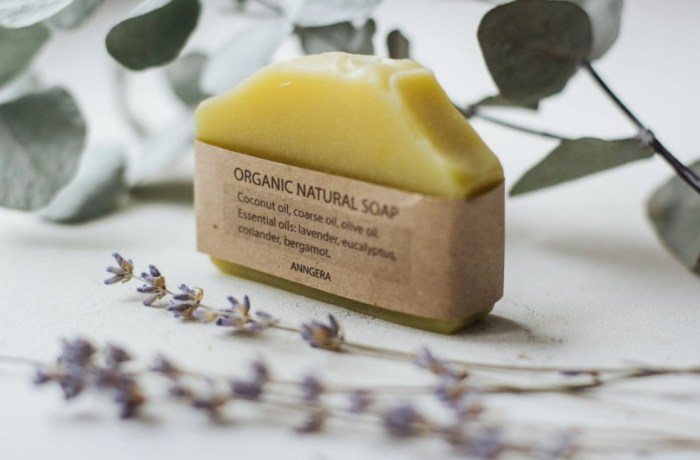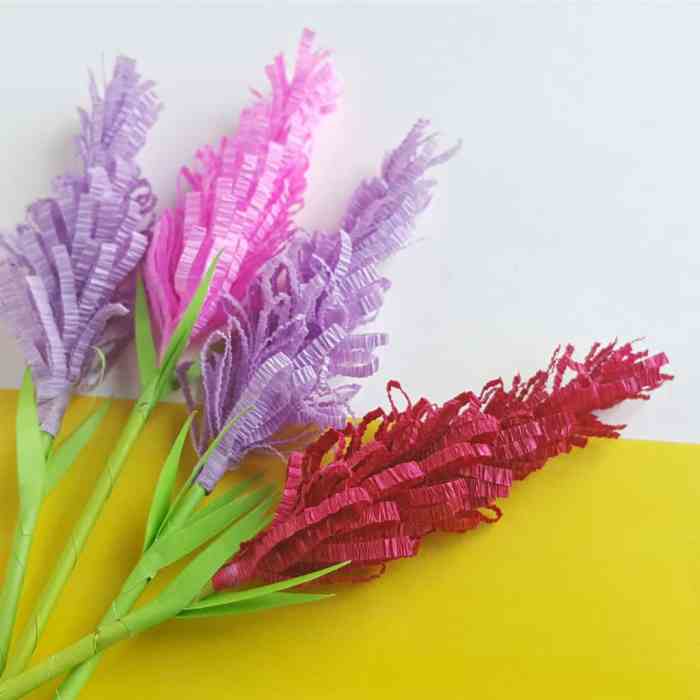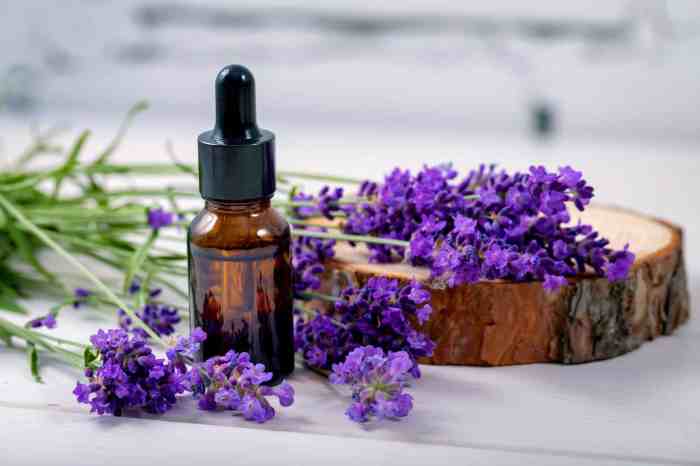DIY lavender essential oil offers a captivating journey into the world of aromatherapy and natural remedies. This guide delves into the history, properties, and benefits of lavender essential oil, guiding you through the process of extracting it at home. From choosing the right lavender variety to mastering distillation techniques, we explore the art of creating your own potent and versatile essential oil.
Discover the secrets of lavender essential oil, its numerous applications in aromatherapy, skincare, and household cleaning. Learn about essential oil blending, dilution, and safety precautions to ensure a rewarding and safe experience. Embrace the transformative power of lavender essential oil and embark on a journey of self-care and natural well-being.
Applications of DIY Lavender Essential Oil

Lavender essential oil, with its calming scent and versatile properties, finds a wide range of applications beyond just its pleasant aroma. From aromatherapy to skincare and household cleaning, this DIY oil can be incorporated into various aspects of your daily life.
Aromatherapy
Lavender essential oil has long been recognized for its calming and relaxing effects, making it a popular choice for aromatherapy. It can be used in a variety of ways to promote relaxation and reduce stress.
- Diffusing: Lavender essential oil can be diffused in a diffuser to fill a room with its soothing scent. This can be particularly helpful before bedtime to promote relaxation and improve sleep quality.
- Inhalations: Adding a few drops of lavender essential oil to a bowl of hot water and inhaling the steam can help to relieve congestion and ease respiratory issues.
- Massage: Lavender essential oil can be diluted in a carrier oil, such as almond oil or coconut oil, and used for massage. This can help to relieve muscle tension and promote relaxation.
DIY Skincare Products
Lavender essential oil is known for its antiseptic, anti-inflammatory, and skin-soothing properties, making it a valuable ingredient in DIY skincare products.
- Lotions: Adding a few drops of lavender essential oil to your favorite lotion can create a calming and fragrant moisturizer. It can also help to soothe irritated skin and reduce inflammation.
- Soaps: Lavender essential oil can be incorporated into homemade soap recipes to create a fragrant and gentle cleanser. It can also help to improve skin tone and reduce blemishes.
- Face Masks: Lavender essential oil can be added to clay-based face masks to create a soothing and cleansing treatment. It can also help to reduce acne and promote skin regeneration.
Household Cleaning Solutions
Lavender essential oil’s natural antibacterial and antifungal properties make it a great addition to household cleaning solutions.
- All-Purpose Cleaner: Mix a few drops of lavender essential oil with water and vinegar to create a natural all-purpose cleaner. This solution can be used to clean surfaces, floors, and countertops.
- Laundry Detergent: Add a few drops of lavender essential oil to your laundry detergent to create a naturally fragrant and refreshing scent.
- Air Freshener: Combine a few drops of lavender essential oil with water in a spray bottle to create a natural air freshener. This can be used to freshen up any room in your home.
Safety Considerations and Precautions: Diy Lavender Essential Oil

While lavender essential oil is generally considered safe for topical use, it’s important to be aware of potential sensitivities and follow proper safety guidelines. Like any essential oil, lavender oil can cause adverse reactions in some individuals.
Potential Allergens and Sensitivities
Lavender essential oil is generally well-tolerated, but some people may experience allergic reactions. These reactions can manifest as skin irritation, redness, itching, or even a rash. In rare cases, individuals may experience more severe allergic reactions, such as difficulty breathing or swelling of the face, lips, or tongue.
- Cross-Sensitivity: Individuals with allergies to other plants in the mint family, such as basil, oregano, or thyme, may also be allergic to lavender. This is because these plants share similar chemical compounds.
- Phototoxicity: Some essential oils, including lavender oil, can increase the skin’s sensitivity to sunlight. This is known as phototoxicity. Applying lavender oil to the skin and then exposing it to sunlight may result in a sunburn or other skin reactions.
Proper Storage and Handling of Essential Oils, Diy lavender essential oil
- Store in a cool, dark place: Essential oils are sensitive to light and heat, which can degrade their quality. It’s recommended to store them in airtight containers in a cool, dark place, away from direct sunlight and heat sources.
- Keep out of reach of children and pets: Essential oils can be toxic if ingested, so it’s crucial to keep them out of reach of children and pets. Ensure proper storage and labeling to prevent accidental ingestion.
- Dilute before use: Essential oils are highly concentrated and should always be diluted before topical application. This helps to reduce the risk of skin irritation or allergic reactions. A general dilution ratio for essential oils is 1-2% in a carrier oil, such as jojoba oil or almond oil.
Consult a Healthcare Professional
It’s essential to consult a healthcare professional before using essential oils, especially if you have any pre-existing medical conditions, are pregnant or breastfeeding, or are taking any medications. Your healthcare provider can advise you on the safe and appropriate use of essential oils for your specific needs.
DIY Lavender Essential Oil Projects

Lavender essential oil is incredibly versatile, offering a wide range of uses beyond aromatherapy. It can be incorporated into various DIY projects to enhance your home, beauty routine, and overall well-being. This section will explore several DIY projects involving lavender essential oil, providing detailed instructions and recipes for each.
Lavender-Infused Candles
Lavender-infused candles are a popular choice for creating a relaxing and aromatic atmosphere. The scent of lavender can help promote calmness and relaxation, making it ideal for bedtime or meditation.
Here’s a simple recipe for lavender-infused candles:
- Ingredients:
- Soy wax flakes
- Wicks (sized appropriately for your container)
- Lavender essential oil
- Glass candle jars
- Double boiler or heat-safe pot and bowl
- Thermometer
- Wooden skewers or chopsticks
- Instructions:
- Prepare your candle jars by cleaning them thoroughly and attaching the wicks to the bottom using a wick sticker or a small amount of hot glue.
- In the double boiler or heat-safe pot and bowl, melt the soy wax flakes over low heat, stirring occasionally until completely melted.
- Once the wax is melted, remove it from the heat and allow it to cool slightly to about 180°F (82°C).
- Add the lavender essential oil to the melted wax. Start with a few drops and gradually add more to achieve your desired scent intensity.
- Pour the scented wax into the prepared candle jars, ensuring the wicks remain centered.
- Use a wooden skewer or chopstick to remove any air bubbles from the wax.
- Allow the candles to cool and harden completely before trimming the wicks.
Lavender Bath Salts
Lavender bath salts are a luxurious and soothing addition to your bath routine. They can help to relax muscles, relieve stress, and promote restful sleep.
Here’s a simple recipe for lavender bath salts:
- Ingredients:
- Epsom salts
- Sea salt
- Lavender essential oil
- Dried lavender flowers (optional)
- Glass jar or container with a lid
- Instructions:
- Combine the Epsom salts and sea salt in a bowl. The ratio can be adjusted to your preference, but a good starting point is a 2:1 ratio of Epsom salts to sea salt.
- Add the lavender essential oil to the salt mixture. Start with a few drops and gradually add more to achieve your desired scent intensity.
- If desired, add dried lavender flowers to the mixture for a more visually appealing and aromatic bath experience.
- Mix the ingredients thoroughly until the essential oil is evenly distributed.
- Store the bath salts in an airtight glass jar or container.
- To use, add a generous amount of bath salts to a warm bath and enjoy the soothing and aromatic experience.
Lavender Pillow Spray
Lavender pillow spray is a great way to promote relaxation and restful sleep. The calming scent of lavender can help to ease anxiety and promote a sense of peacefulness, making it easier to drift off to sleep.
Here’s a simple recipe for lavender pillow spray:
- Ingredients:
- Witch hazel
- Water
- Lavender essential oil
- Spray bottle
- Instructions:
- In a spray bottle, combine the witch hazel and water. A good starting point is a 50/50 mixture.
- Add the lavender essential oil to the mixture. Start with a few drops and gradually add more to achieve your desired scent intensity.
- Shake the bottle well to mix the ingredients thoroughly.
- To use, spritz a few sprays of the lavender pillow spray onto your pillow and bedding before going to sleep.
Lavender Massage Oil
Lavender massage oil is a relaxing and therapeutic option for easing muscle tension and promoting relaxation. The soothing scent of lavender can help to calm the mind and body, while the massage itself can help to relieve stress and promote overall well-being.
Here’s a simple recipe for lavender massage oil:
- Ingredients:
- Carrier oil (such as almond oil, jojoba oil, or coconut oil)
- Lavender essential oil
- Glass bottle with a dropper or pump
- Instructions:
- In the glass bottle, combine the carrier oil and lavender essential oil. Start with a few drops of lavender essential oil and gradually add more to achieve your desired scent intensity. A general guideline is to use 10-15 drops of essential oil per ounce of carrier oil.
- Shake the bottle well to mix the ingredients thoroughly.
- To use, apply a small amount of lavender massage oil to your hands and massage it into your skin. You can also use it to massage sore muscles or to relax before bedtime.
Creating your own lavender essential oil opens a world of possibilities for natural wellness and self-care. From calming aromatherapy blends to invigorating skincare products, the benefits are numerous and readily accessible. Embrace the journey of crafting your own essential oil, and experience the transformative power of lavender’s natural essence.
Creating your own lavender essential oil is a rewarding process, allowing you to enjoy the calming scent of lavender in your home. If you’re looking for a fun and creative DIY project, consider making some DIY concrete pumpkins to decorate your space. Once your pumpkins are complete, you can add a few drops of your homemade lavender essential oil to create a soothing and aromatic atmosphere.
